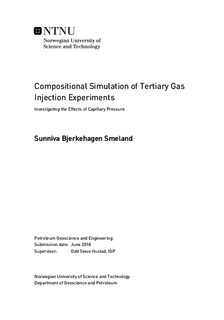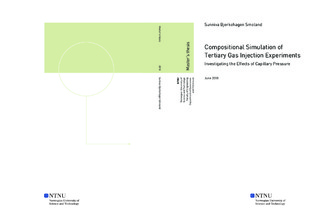| dc.description.abstract | Tertiary gas injection is an enhanced oil recovery method, which aims for reducing residual oil in a reservoir by gas injection. Tertiary gas injection induces a system of three-phase where water, oil and gas flow simultaneously in a porous medium. Three-phase flow increases the complexity of a system, as dynamic rock properties such as capillary pressure and especially relative permeability are difficult to measure. Because of the insecurities related to measured three-phase relative permeability, mathematical and empirical models are often used to calculate three-phase relative permeability rather than implementing experimentally obtained data.
Datasets from two tertiary gas injection experiments conducted on Bentheimer sandstone cores are studied. Equilibrium gas to the existing oil was injected in Experiment 1, while dry separator gas was injected in Experiment 2. Experiment 1 was kept under certain conditions to avoid mass transfer between components. In Experiment 2 mass transfer through vaporization was present and an additional water recovery was observed in the experimental production data.
In this study the mentioned tertiary gas injection experiments are simulated and history matched with a compositional model applying a three-phase relative permeability model called Extended Stone model 1. The overall goal of this study is to achieve a satisfactory match for all fluid recoveries with an emphasis on capillary pressure effects. The extra water recovery observed in Experiment 2 is attempted history matched by applying gas-water capillary pressure data, which is usually not implemented in a typical simulation model applying Extended Stone model 1. In addition to the simulation study, the current thesis contains a comprehensive literature review on three-phase relative permeability and tertiary gas injection publications.
A match of all fluid recoveries is achieved for both experiments. Extended Stone model 1 together with applying gas-water capillary pressure data seem to be sufficient for history matching the two different tertiary gas injection experiments where one include mass transfer and one does not. The match of Experiment 2 is however not perfect, which indicates that Extended Stone model 1 is not ideal for simulation of mass transfer experiments on a component level. However, the simulations show promising results and can be an indicator for future developments of simulation of three-phase flow. | |

